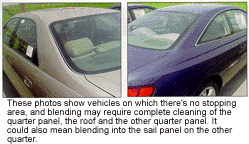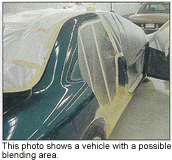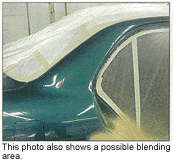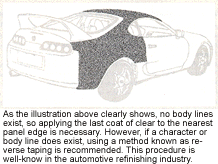As a follow up to the article, “Ending the Blending Debate” (published in the August 1999 issue of BodyShop Business), I wanted to take a closer look at a few issues regarding the blending process.
For the most part, today’s industry – repairers and insurers – agrees that it’s proper to set up for a blend into the adjacent panels from the beginning. This process includes the necessary operations, such as removing and re-installing (R&I) moldings and trim items on the panels. This agreement is, of course, on a national level.
Locally, however, repairers are often faced with an adjuster/appraiser making decisions that fly in the face of these national policies. The reason: I believe it takes time for “new ideas” to hit home – but I have faith they will someday.
For those repairers still dealing with insurers who fail to recognize this blending procedure, I feel for your situation. Insurers in your area are apparently uneducated (or uncaring) in what it takes to restore a vehicle back to pre-accident condition. But believe me, it’s only a matter of time before policy retention for these companies declines and their concerns change.
On the flip side, it’s equally important that the procedures you bill for are performed every time. If you’re paid to blend the panels, then either blend the panels or remove it from the bill. Don’t shift it somewhere else. This includes any R&I of trim or moldings as well. If you don’t do it, you shouldn’t get paid for it.
The focus of this article, however, isn’t to lecture you on the evils of cost shifting (that deserves its own article), but to look at some technical challenges and decisions that must be made today concerning blending.
To Blend or Not to Blend – Is That the Right Question?
I know it sounds contrary to what was just said, but there’s more to consider when we get into some adjacent panels – namely when the panel includes a roof and/or a quarter panel.

Why is this a problem?
The recommended process when blending within or even into adjacent panels is to blend the base colors into the existing vehicle color to create the illusion of a perfect match. But with basecoat systems, a clearcoat must be applied over the panel as well. The proper process generally requires that the entire panels be cleared for most systems to provide the paint manufacturer’s lifetime warranty.
In my first article, I discussed the procedure of blending your clear to the end of the panel (if it’s allowed by the paint system) so only one coat is applied at the edge of the panel. This decreases the odds of the clear darkening the blend panel to the point it doesn’t match the next panel. This option may or may not be available with your paint system and is normally only a problem on certain color families, such as light metallics.
Gone are the days of vinyl tops, so quarter panels and roofs form a continuous panel to blend. This causes the clear to be applied over the entire area if we use the process just mentioned. Of course, this is an area of debate and disagreement between insurers and repairers worldwide.
A number of years ago, I-CAR attempted to address this procedure by stating that each repair is unique and a case-by-case determination must be made. This determination would include the age of the vehicle, the customer’s expectations, the vehicle’s design, the manufacturer’s recommendation, and the location and extent of damage. That covers just about everything, right?
Let’s try to explain this in “real terms.” The recommended procedure is to clear the entire area. In other words, the clear is applied over both quarter panels and rockers (if designed this way), the roof panel and A-pillars. In some areas of the country, this is called “wrapping” the vehicle, which means the clear will be applied to the entire area.
And the Manufacturer Says …
Some auto manufacturers – Toyota, Acura, Infiniti, Lexus and Honda to name a few – provide a written position on blending. Others provide no support for or against the procedure. Why the discrepancy? I call it the “manufacturer’s dilemma.”

First, keep in mind that auto manufacturers are in the business to sell vehicles and replacement parts, so they’re not primarily concerned with all aspects of the repair process. Why would they be? Unless it’s a safety concern or an area that allows their vehicle to receive a better insurance rating, they probably shouldn’t be directly involved. If the involvement sells more vehicles or parts, then it’s probably an area they’ll be involved in. Don’t expect otherwise, and you won’t be disappointed.
Another dilemma manufacturers face today is that if they take a position or write a procedure on a specific vehicle or repair process, they’ll surely have to defend it in court someday. Plus, they’ll need to continue maintenance on the process to examine newer products and equipment that may affect their original position or procedure. And that’s expecting a lot from a manufacturer, especially the way our legal system can rack up the expenses.

As the Toyota insert explains (see diagram), if a quarter panel needs complete refinishing and there’s no definite break line to reverse tape, then the recommended procedure is to clear the entire area (roof, other quarter panel, etc.). Other manufacturers may not provide any written documents on this subject, but don’t confuse a lack of a written position with an OK to blend the area.
As mentioned, auto manufacturers aren’t in the business to research new products, equipment or procedures for all repairs. So why is it important to know that innovation comes from the aftermarket and not the original equipment manufacturers (OEMs)? I’ve heard many times that the reason a process is used by a shop is because “the OEM says to.” But that may not be your best line of defense. Ultimately, you – the shop owner- are responsible for repairs (most states umbrella technicians in liability references). Since you’re responsible, you must make a business decision in all repair procedures performed – including blending.
Play by the Rules
If your paint system offers a clear blending method, there will certainly be guidelines to follow. The following should assist you in making sure you have the bases covered:
1. Get the procedure in written form for documentation.
2. Get any warranty information in writing.
3. Follow the procedure. (Don’t create your own process unless the paint manufacturer agrees, then refer back to my first point.)
In most cases, the blending process will carry limits. The clear won’t be blended on a horizontal surface, such as a hood, roof or decklid, since the sun will attack it and cause a scaling failure. The manufacturer will also recommend that blending take place in the narrowest area of the adjacent quarter panel (sail panel area).
The recommended blending method may also carry a different warranty, so read the fine print. There will be repairs for which this blending method is acceptable and others where it isn’t. You’ll make the call on each vehicle based on the particular repair situation.
Warranties: What Matters to the Customer
The products you use and how you use them determine the longevity of each repair. If a paint failure occurs and it’s product related, be prepared to fix the problem to satisfy the vehicle owner and retain him as a future customer.
Today’s customers understand there will be failures. The key is that the warranty is honored and that they’re made whole again. The whole process this creates is extremely important. I suggest you prepare for this and get commitment from your product supplier to provide a letter that apologizes for the product failure and expresses concern with working through a “certified” service provider (that’s you) to meet the customer’s expectations. This – coupled with your solving the problem immediately – will certainly benefit your business and reputation.
The Continued Blending Debate
The products, process and location of blending the clearcoat is critical to your success. You need to make a business decision to use the most advanced products your system has to offer and the proper process designed to make them work. You also need to use your own judgment: Let your experience dictate what’s best for your customer on each job.
Contributing editor Tony Passwater is president of AEII, a consulting, training and system-development company. He’s been in the industry for more than 27 years; has been a collision repair facility owner, vocational educator and I-CAR international Instructor; and has taught seminars across North America, Korea and China. He can be contacted at (317) 290-0611, ext. 101, or at ([email protected]).Visit his Web site at www.aeii.net for more information.
|
A Word from Toyota …
The following Toyota insert explains the manufacturer’s position on blending. If a quarter panel needs complete refinishing and there’s no definite break line to reverse tape, then the recommended procedure is to clear the entire area (roof, other quarter panel, etc.). Other manufacturers may not provide any written documents on blending, but don’t confuse a lack of a written position with an OK to blend the area. TITLE: REFINISH PROCEDURES FOR PANELS WITHOUT BODY LINES Late model Toyota vehicles offer eye-pleasing customer appeal associated with leading edge technology. As body styles continue to get smoother and more aerodynamic, refinish technicians face difficult decisions in meeting customer expectations when refinishing smooth panels without body lines. Historically, refinish technicians used a technique called “solvent blending” on areas without character or body lines. This system worked well on old technology thermoplastic/thermoset finishes. However, vehicles today utilize more sophisticated paints applied at the factory that do not lend themselves to this type of repair procedure. The reason is simple: The bond between the OEM finish and the newly applied refinish paint cannot “blend” or “melt” into one another. Problems directly attributed to solvent blending are:
To meet this challenge and maintain environmental compliance, Toyota recommends the following procedure for restoring your customer’s vehicle to pre-accident condition:
The process is fundamentally the same for refinishing any panel, but the professional difference is where the application of the clearcoat ends. Spraying the final full coat ensures maximum adhesion and ultra-violet sunlight protection and is environmentally safer. Over-reduced clearcoats, used during a solvent blend, cannot provide the same level of high quality repairs. 
|













